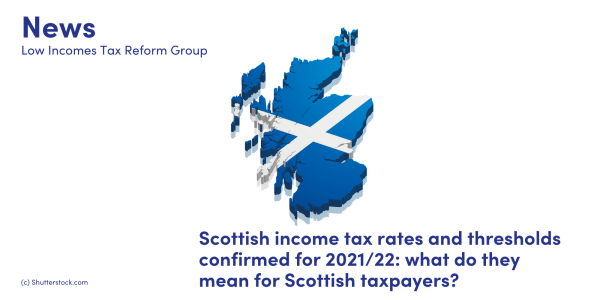Scottish income tax rates and thresholds confirmed for 2021/22: what do they mean for Scottish taxpayers?
The Scottish Parliament has confirmed the rates and thresholds for Scottish income tax that will apply to the non-savings and non-dividend income of Scottish taxpayers from 6 April 2021.

Content on this page:
What are the rates and bands for Scottish income tax for 2021/22?
The rates and bands for Scottish income tax from 6 April 2021 are set out below:
|
Scottish income tax rates 2021/22 |
Scottish income tax bands 2021/22* |
|
Scottish starter rate – 19% |
£12,571 – £14,667 (£2,097) |
|
Scottish basic rate – 20% |
£14,668 – £25,296 (£10,629) |
|
Scottish intermediate rate – 21% |
£25,297 – £43,662 (£18,366) |
|
Scottish higher rate – 41% |
£43,663 – £150,000 |
|
Scottish top rate – 46% |
£150,001 and above |
* The bands assume the taxpayer is eligible for the UK-wide personal allowance for 2021/22 of £12,570. The personal allowance reduces by £1 for every £2 of income over £100,000. So, taxpayers with income of more than £125,140 do not have any personal allowance.
What income do I pay Scottish income tax on?
If you are a Scottish taxpayer, you pay Scottish income tax according to the Scottish income tax rates and bands on your non-savings and non-dividend income.
Non-savings and non-dividend income includes profits from rental property, and earned income, such as employment income, pension income and profits from self-employment.
If you are a Scottish taxpayer, you continue to pay income tax according to the UK rates and bands of income tax on your savings and dividend income.
Am I a Scottish taxpayer?
There is more information about who is a Scottish taxpayer in our tax basics section, but in essence, if your home is in Scotland for more than half of a tax year, you are a Scottish taxpayer.
What are the key differences between Scottish income tax and UK income tax?
The key differences between Scottish income tax rates and bands and UK income tax rates and bands are that:
- Scottish income tax has five bands compared to three bands for UK income tax. The basic rate band has effectively been split into three – the starter, basic and intermediate rate bands;
- Scottish income tax has a top rate band whereas UK income tax has an additional rate band as the highest rate band of tax;
- The Scottish higher and top rates are 41% and 46% respectively – the UK higher and additional rates are 40% and 45%.
- The point at which you start to pay higher rate tax is different. If we assume that you are a Scottish taxpayer and eligible for the personal allowance (£12,570 in 2021/22), your higher rate threshold for your non-savings non-dividend income is £43,662. If you are a UK taxpayer, your higher rate threshold in 2021/22 is £50,270.
These points of divergence between the Scottish and UK rates and bands inevitably create some complexities for Scottish taxpayers. For example, Scottish taxpayers who have savings and dividend income as well as earned income, have to consider both the Scottish and the UK rates and bands when working out their tax liability. We explore these complexities in a blog on the Chartered Institute of Taxation website.
What is the effect for those on low incomes?
Because of the starter rate band (19%), Scottish taxpayers with non-savings non-dividend income of less than £27,393 in 2021/22 will pay less income tax than taxpayers in the rest of the UK earning the same level of income. The difference in tax liability is relatively small, at a maximum of just over £20 for the tax year.
Scottish taxpayers who are also claiming universal credit or means-tested benefits are likely to see a significantly smaller reduction, perhaps of around £7 for the year, because a £20 increase in their net taxable income will reduce their universal credit entitlement by 63%.
Example
We can take the example of Ben to illustrate the difference between UK and Scottish income tax liabilities on incomes below £27,393.
Ben has employment income of £22,000 for 2021/22.
|
£ |
£ |
|
|
Employment income |
22,000 |
|
|
Personal Allowance |
(12,570) |
|
|
Total Taxable income |
9,430 |
|
|
Starter rate band (19%) |
2,097 |
398.43 |
|
Basic rate band (20%) |
7,333 |
1,466.60 |
|
Total Scottish income tax due |
1,865.03 |
If Ben was a UK taxpayer, rather than a Scottish taxpayer, he would pay tax on his total taxable income of £9,430 at the UK basic rate of 20%, giving a total tax liability of £1,886. As a Scottish taxpayer, Ben only has to pay £1,865.03, which is £20.97 less.
Who collects Scottish income tax?
Although the Scottish Parliament sets the rates and thresholds for income tax payable by Scottish taxpayers on certain types of income, HM Revenue & Customs (HMRC) continue to collect and administer all income tax. This means that if you have any questions about your income tax, including your Scottish income tax, you should contact HMRC.
If you are a Scottish taxpayer and have PAYE income from an employer or a pension provider, you should have a Scottish PAYE tax code (an “S” code).
Why is it important to tell HMRC my correct address?
Your correct and up-to-date address is a key factor in determining whether or not you are a Scottish taxpayer. It is not the only factor, but it will be decisive in many cases.
In addition, HMRC send correspondence, including repayments of tax, to the address they have on file. You can tell HMRC your up-to-date address using their online service.
Where can I find more information about Scottish income tax?
You can find more information about Scottish income tax in the tax basics section.
